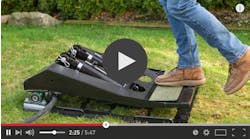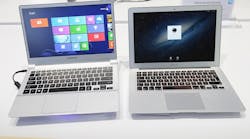Fisher Dynamics taps Glass to improve efficiency and productivity across its St. Clair Shores factory.
Forget how goofy they look or that creepy vibe they seem give off in the outside world. When we look at Google Glass, our first question has always been, "Can they work in the factory?"
Until recently, there hasn't been any firm answer there. The clumsiness of the prototype's designs and programming seemed to prevent much exploration and the idea of walking around a plant full of equipment and danger with a screen stuck in front of your face had safety managers howling.
However, up in St. Clair Shores, Mich., Fisher Dynamics has seems to have finally solved the Glass puzzle.
According to IndustryWeek's Matt LaWell, Fisher worked with Plex Systems to design a robust scanning system that combines Glass with a fingertip scanner to scan and check barcodes on the floor.
Combined, the system eliminates handheld scanner, confirming scans, and precious wasted seconds.
When the wearable scanner is used, an alert will flash near that right eye sensor, automatically indicating that the code was entered. Because that alert is in natural peripheral vision, there’s no need to check a separate screen.
As LaWell writes: "Each hands-free scan is about a second faster than the more traditional hand-held scan. That might not sound like much time – until you consider Fisher scans thousands of bar codes every shift. If one person scans 2,000 codes in an eight-hour shift and trims one second with each, that works out to more than 33 minutes per day."
Glass is also used across the factory monitor floor efficiency at a glance, sending operators color-coded messages on the heads-up display about whether the corresponding work station is running efficiently (green), adequately (yellow) or poorly (red).
Fisher is exploring expanded use of the technology, including for its maintenance workers, who could access instructions, troubleshoot and correspond with others on Glass.
Until recently, there hasn't been any firm answer there. The clumsiness of the prototype's designs and programming seemed to prevent much exploration and the idea of walking around a plant full of equipment and danger with a screen stuck in front of your face had safety managers howling.
However, up in St. Clair Shores, Mich., Fisher Dynamics has seems to have finally solved the Glass puzzle.
According to IndustryWeek's Matt LaWell, Fisher worked with Plex Systems to design a robust scanning system that combines Glass with a fingertip scanner to scan and check barcodes on the floor.
Combined, the system eliminates handheld scanner, confirming scans, and precious wasted seconds.
When the wearable scanner is used, an alert will flash near that right eye sensor, automatically indicating that the code was entered. Because that alert is in natural peripheral vision, there’s no need to check a separate screen.
As LaWell writes: "Each hands-free scan is about a second faster than the more traditional hand-held scan. That might not sound like much time – until you consider Fisher scans thousands of bar codes every shift. If one person scans 2,000 codes in an eight-hour shift and trims one second with each, that works out to more than 33 minutes per day."
Glass is also used across the factory monitor floor efficiency at a glance, sending operators color-coded messages on the heads-up display about whether the corresponding work station is running efficiently (green), adequately (yellow) or poorly (red).
Fisher is exploring expanded use of the technology, including for its maintenance workers, who could access instructions, troubleshoot and correspond with others on Glass.










